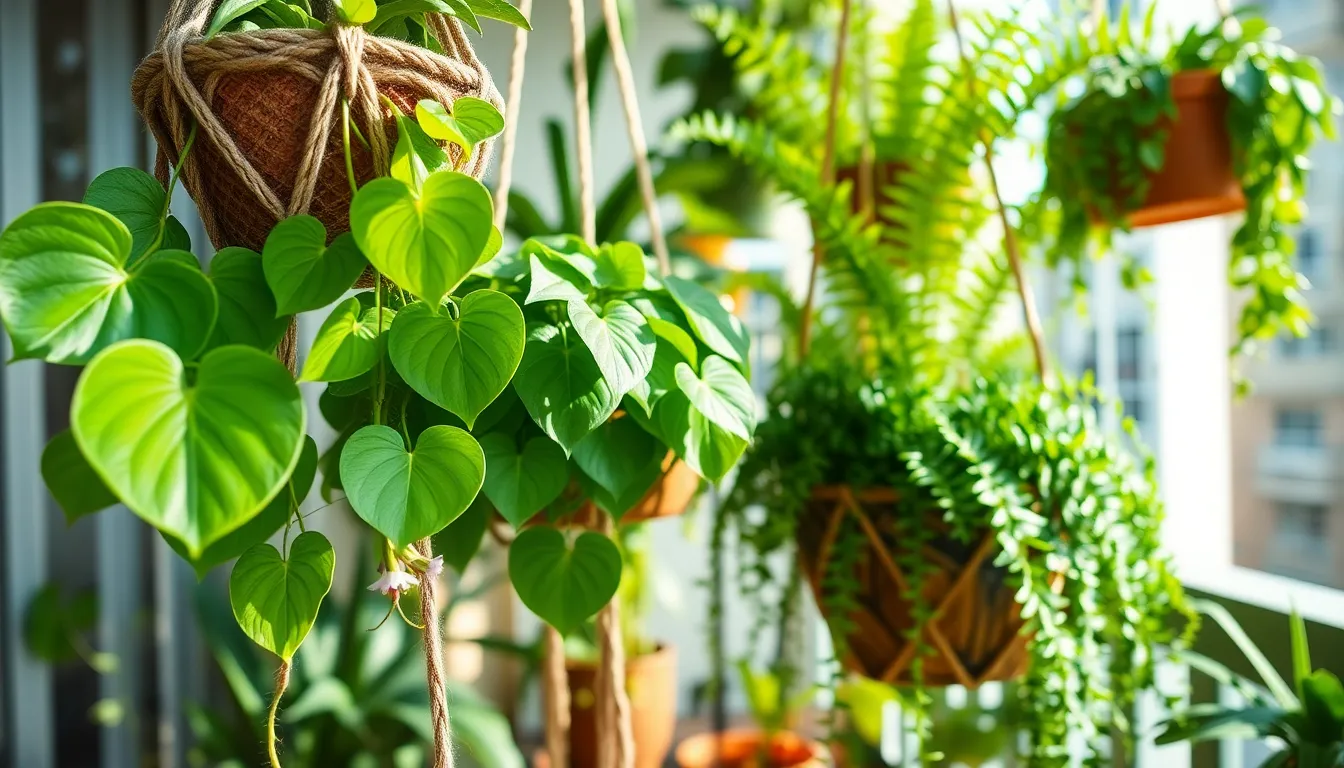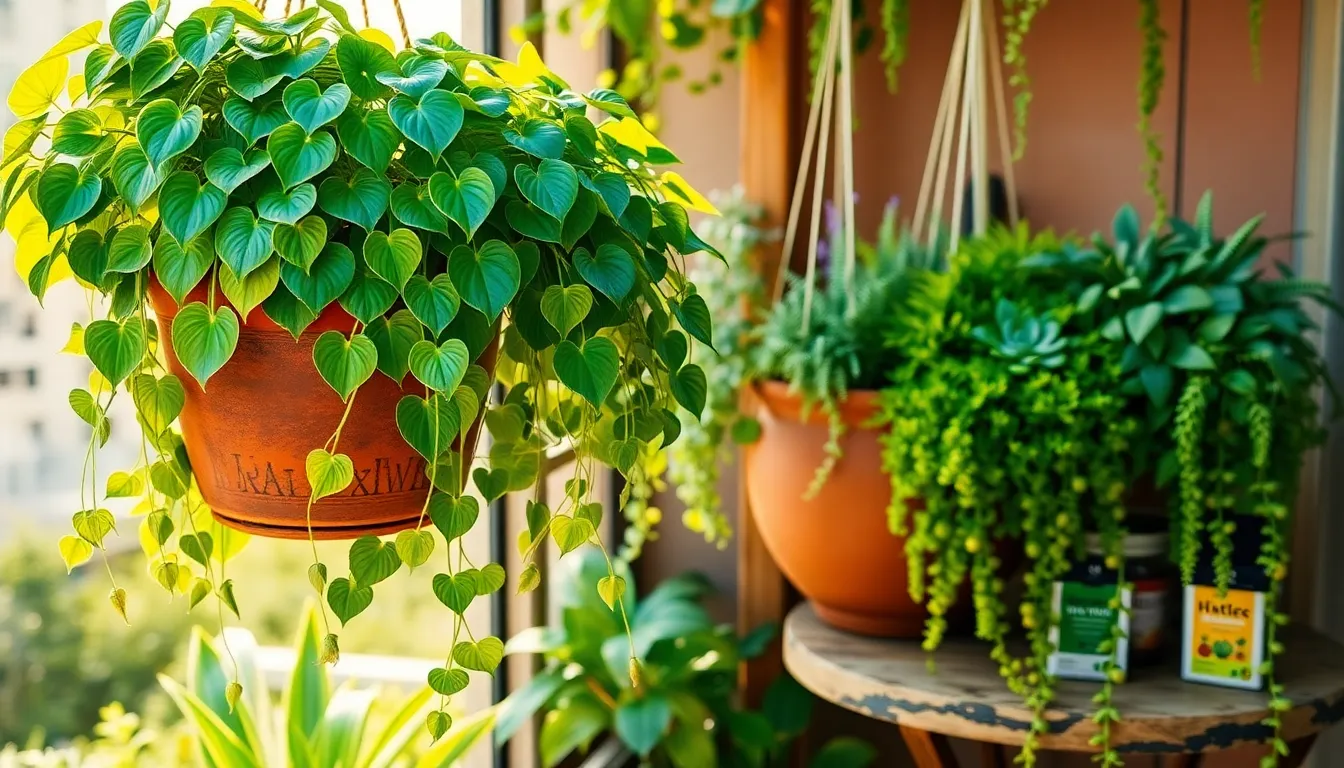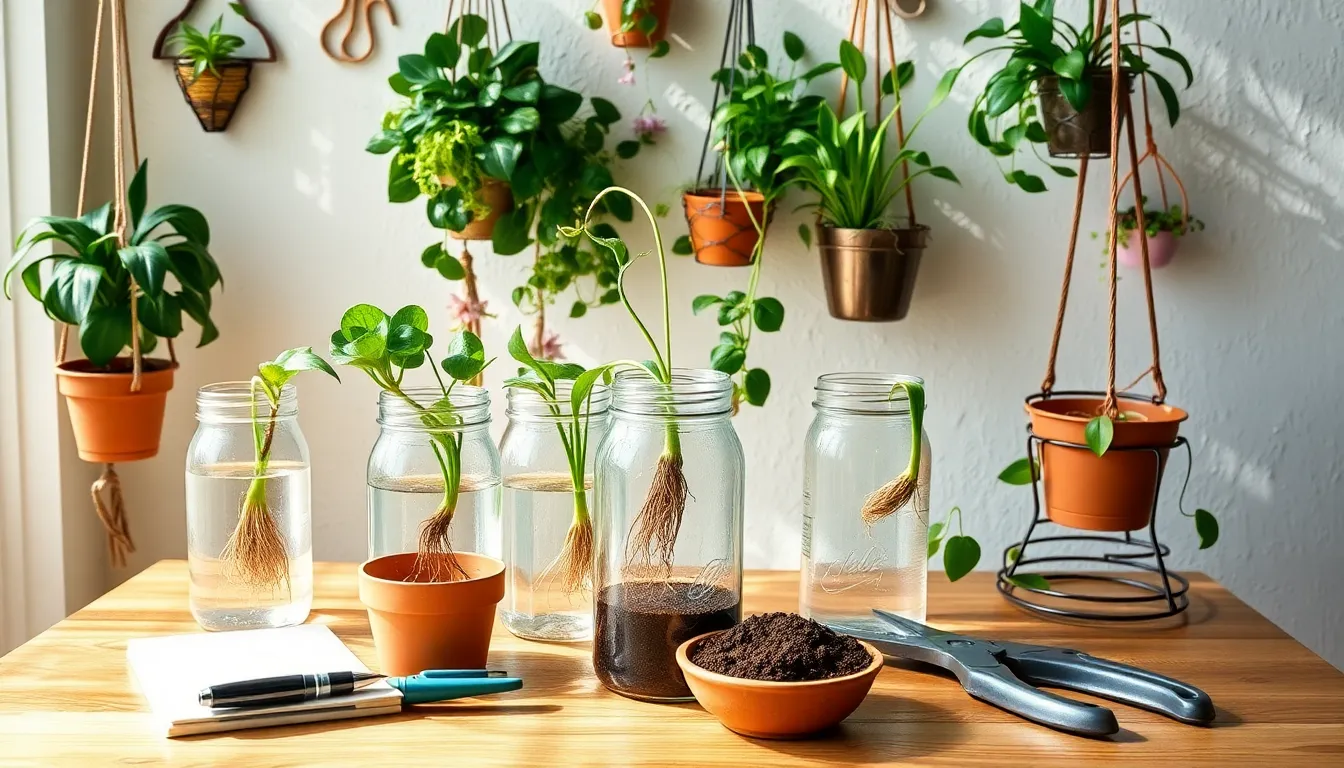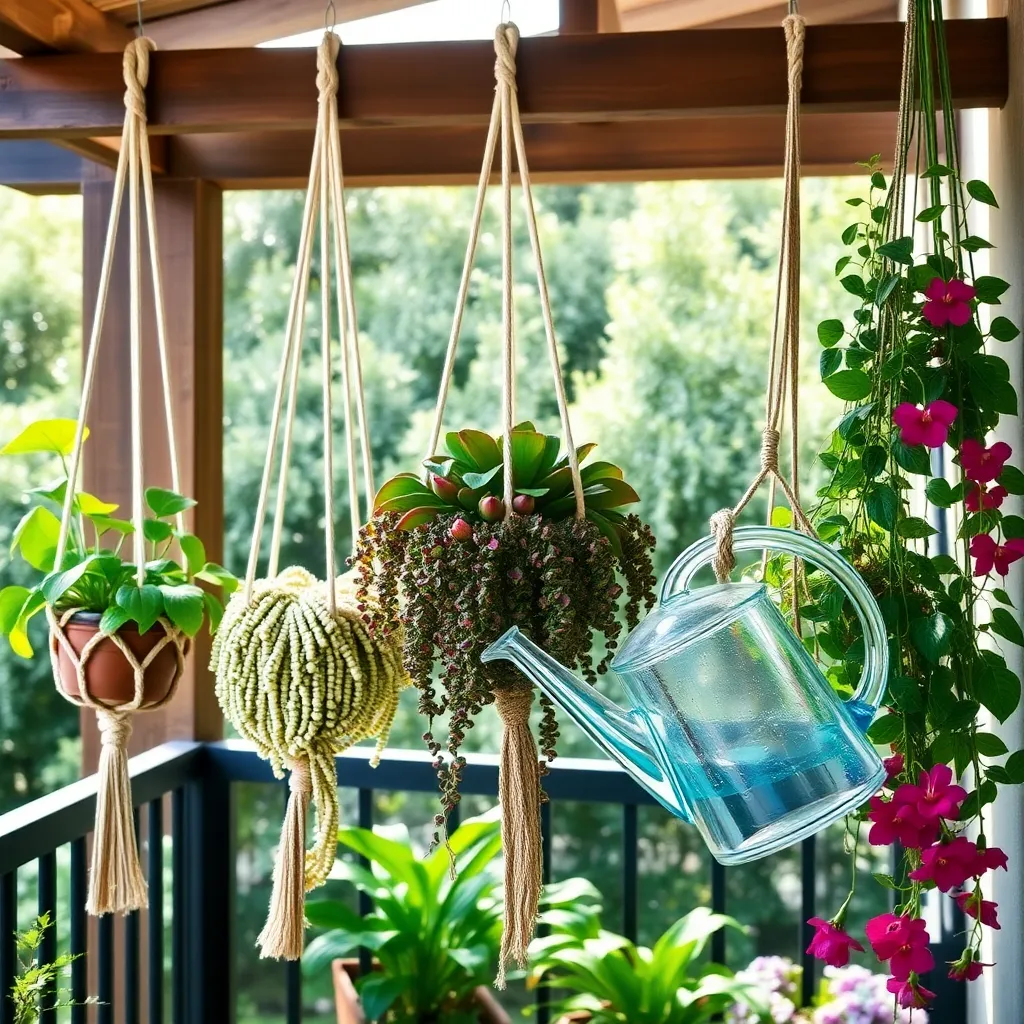Hanging plants have a unique way of transforming any space into a lush, vibrant haven, bringing a touch of nature right into your home. Whether you’re just embarking on your gardening journey or you’re a seasoned green thumb, this guide promises a wealth of insights to help your hanging plants not just survive, but truly thrive.
In “20 Expert Tips for Thriving Hanging Plants,” you’ll discover the magic of these cascading beauties and learn how to unlock their full potential. With practical advice tailored for all levels, you’ll gain the confidence to create stunning displays that elevate your home décor and purify your air, all while experiencing the joy and satisfaction that only a flourishing garden can provide.
Choose Lightweight Pots for Hanging
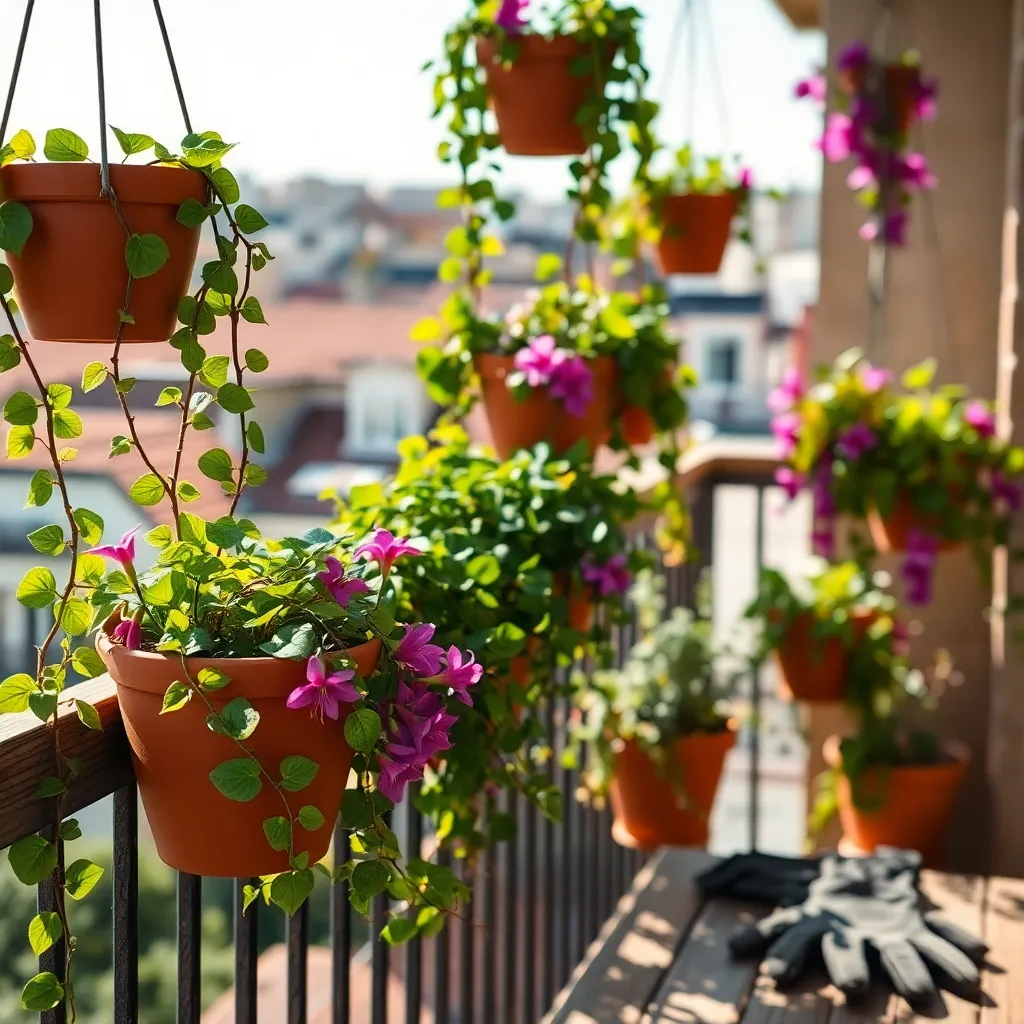
When selecting pots for your hanging plants, prioritize lightweight materials such as plastic, fiberglass, or resin. These materials are not only easier to hang but also reduce the risk of damage to your structure or ceiling.
Consider drainage as a critical factor when choosing a pot, as it affects the overall health of your plants. Look for pots with multiple drainage holes or ones that allow you to drill additional holes if needed.
Avoid using heavy ceramic or clay pots, especially for larger plants, as they can become cumbersome and unsafe. Instead, focus on finding pots with a sturdy construction that can support the weight of the plant and potting mix without adding unnecessary bulk.
If you’re an advanced gardener, experiment with self-watering hanging pots to maintain optimal moisture levels. These pots have a reservoir at the bottom that provides consistent hydration, reducing the frequency of watering and ensuring your plants thrive with less effort.
Select Suitable Plant Varieties
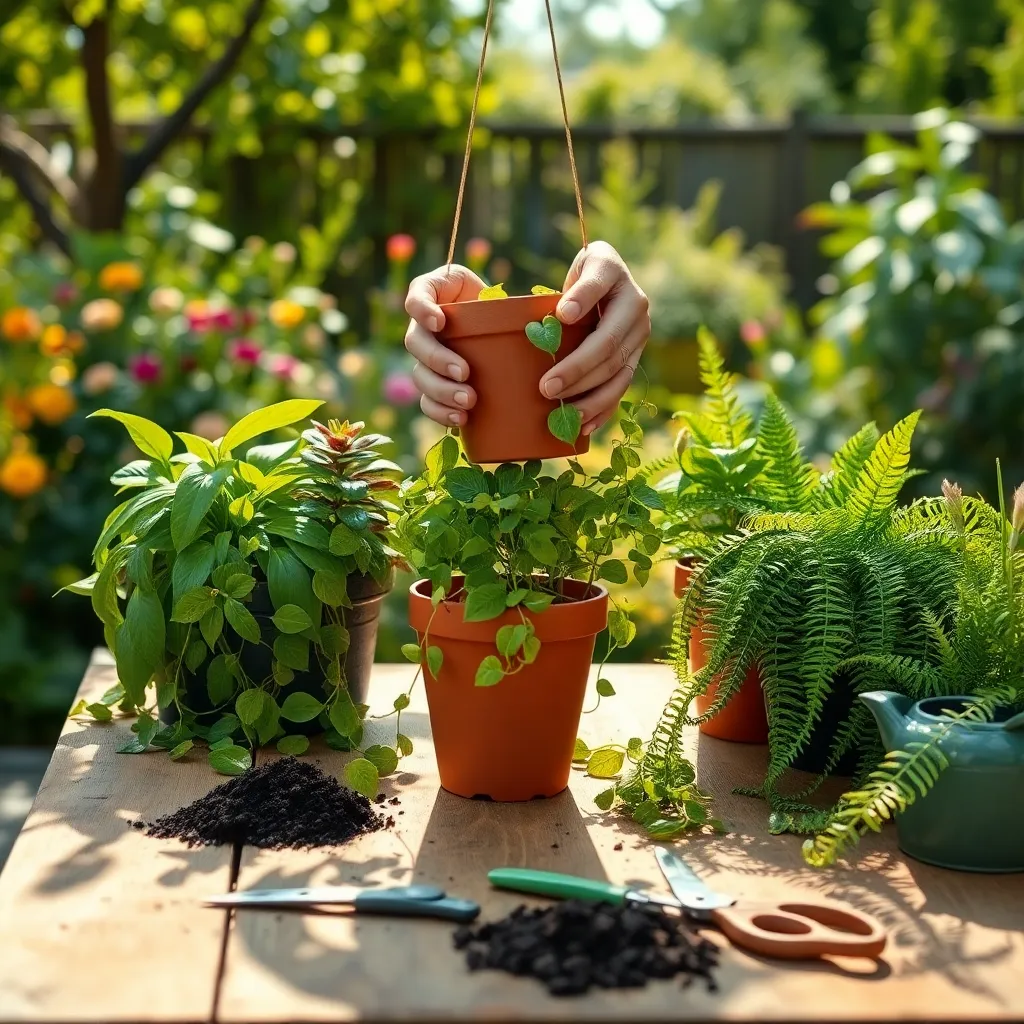
Selecting the right plant varieties is crucial for successful hanging gardens. Choose plants that naturally grow well in containers and have a cascading or trailing habit, such as *pothos* or *string of pearls*.
Consider the light conditions of the space where you plan to hang your plants. For bright, indirect light, try varieties like ferns or spider plants, while succulents and geraniums thrive in direct sunlight.
It’s important to match the plant’s water needs with your ability to maintain them. Choose drought-tolerant varieties like *succulents* if you prefer watering less frequently, or go for moisture-loving plants like *Boston ferns* if you can water regularly.
For those seeking a challenge, consider adding flowering varieties like *fuchsias* or *lobelias*, which add vibrant color to your hanging display. Remember to deadhead regularly to encourage continuous blooming throughout the growing season.
Ensure Proper Drainage Holes
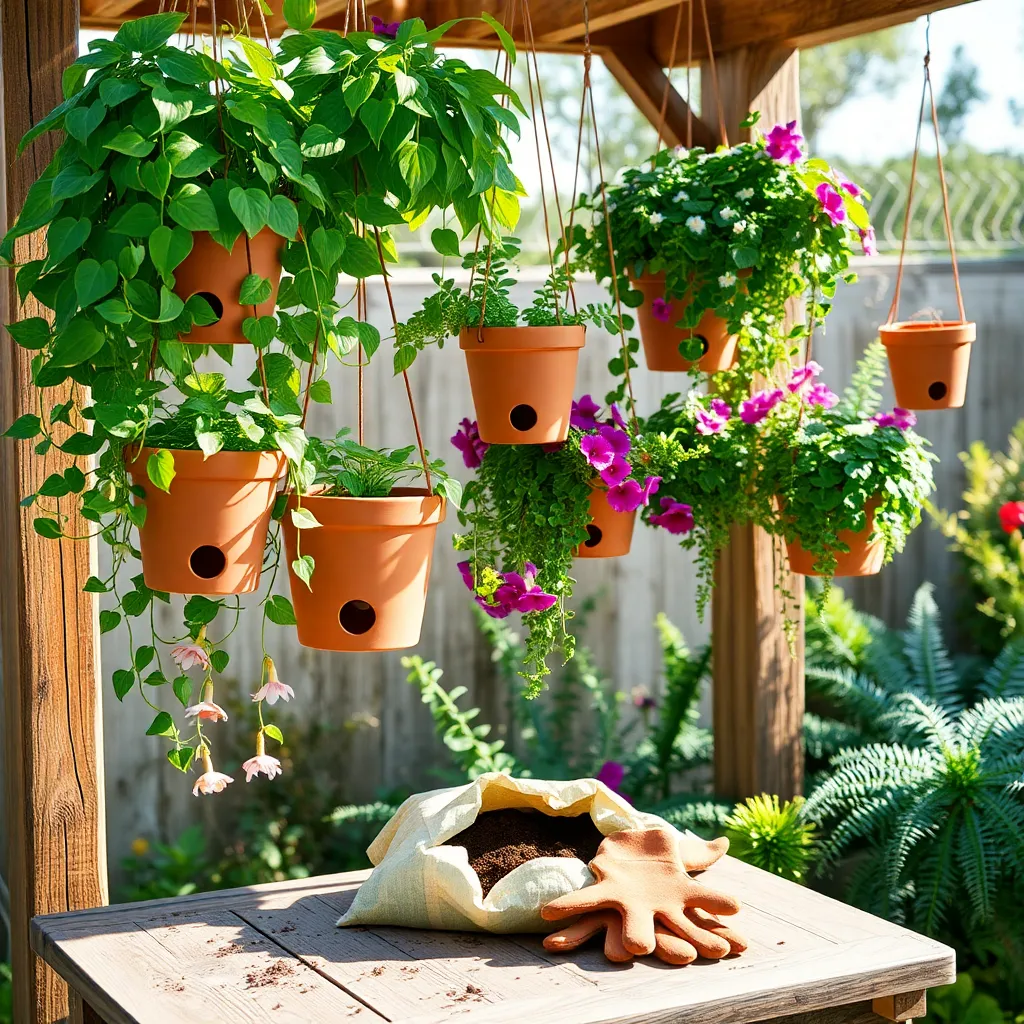
Ensuring proper drainage holes in your hanging plant containers is crucial for healthy plant growth. Without these, excess water can accumulate, leading to root rot and other serious issues that can jeopardize your plants’ health.
To create effective drainage, start by selecting containers with pre-drilled holes, or use a drill to add your own. Aim for at least one hole per 4 inches of pot diameter, as this helps water escape efficiently while maintaining adequate soil moisture.
For gardeners using decorative pots without holes, consider double-potting your plants. Place your plant in a smaller container with drainage, then nestle it inside the decorative pot, allowing excess water to collect in the outer container without harming the roots.
Advanced gardeners might opt for self-watering pots with built-in drainage and water reservoirs. These pots not only prevent overwatering but also reduce the frequency of watering, making them ideal for busy gardeners looking to maintain lush, thriving hanging plants with minimal effort.
Use High-Quality Potting Mix
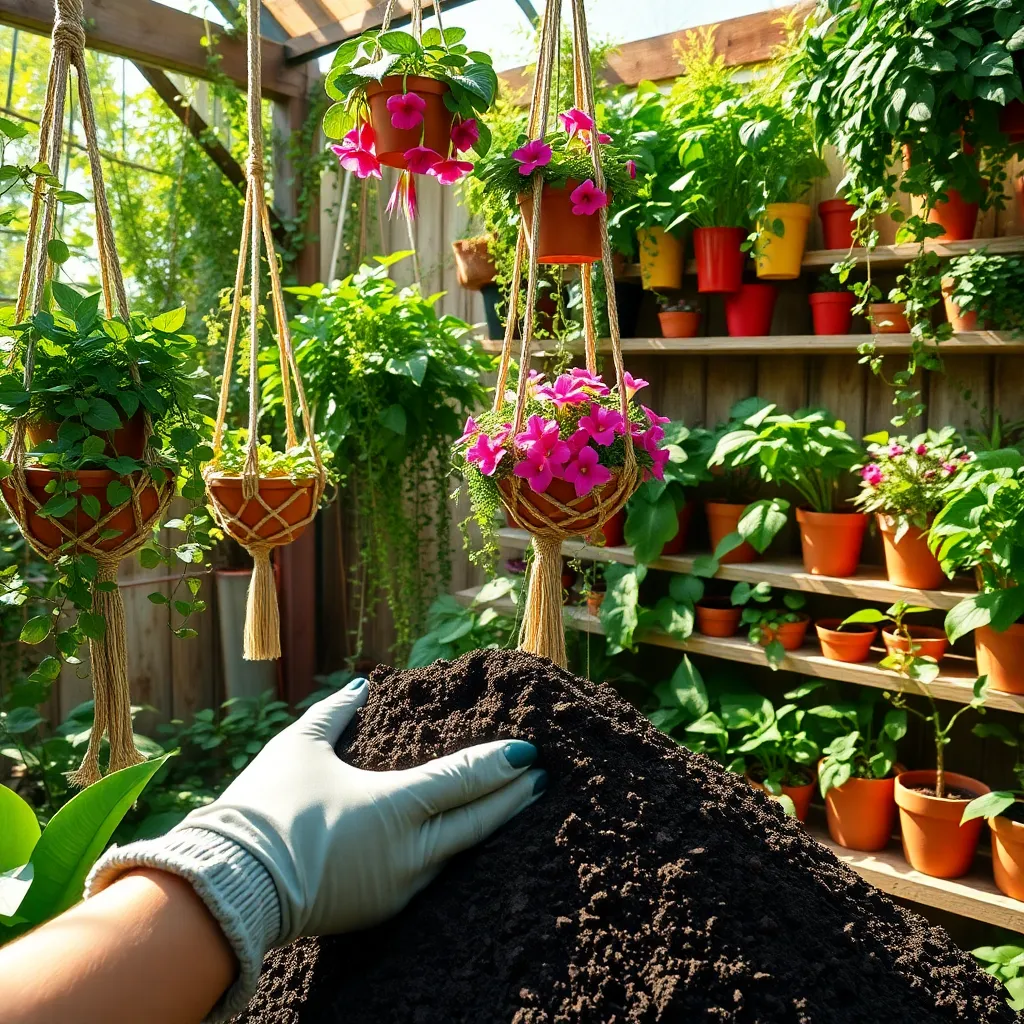
Choosing a high-quality potting mix is crucial for the health of your hanging plants. Unlike garden soil, potting mix is designed to provide the ideal balance of nutrients, moisture retention, and aeration, which helps your plants thrive in their suspended environment.
Look for a potting mix that contains components like peat moss, vermiculite, or perlite, which aid in maintaining moisture without waterlogging. These ingredients ensure that your hanging plants have access to air and water, crucial for healthy root development.
For those looking to give their plants an extra boost, consider a potting mix that includes slow-release fertilizers. This eliminates the need for frequent feedings and ensures your plants receive a steady supply of nutrients over time, supporting robust growth and vibrant foliage.
Advanced gardeners might opt to customize their potting mix by adding ingredients like coco coir for improved moisture management or worm castings for additional nutrients. Experimenting with different blends can help you find the perfect mix that meets the specific needs of your hanging plants, leading to impressive results.
Water Thoroughly, Allow to Dry

When it comes to watering your hanging plants, the principle of “water thoroughly, allow to dry” is key. This means you should saturate the soil until water drains out of the bottom, ensuring the entire root ball receives moisture.
After watering, allow the top inch of the soil to dry out before the next watering session. This practice helps prevent root rot, a common issue in hanging plants when they sit in overly wet soil.
Beginners should check soil moisture by inserting their finger about an inch into the soil. If it feels dry, it’s time to water again; if it’s still moist, wait a few more days before checking again.
For more advanced gardeners, consider investing in a moisture meter for more precise readings. These devices offer a more accurate gauge of when your plants need water, especially helpful for those with extensive collections.
Rotate Plants for Even Growth
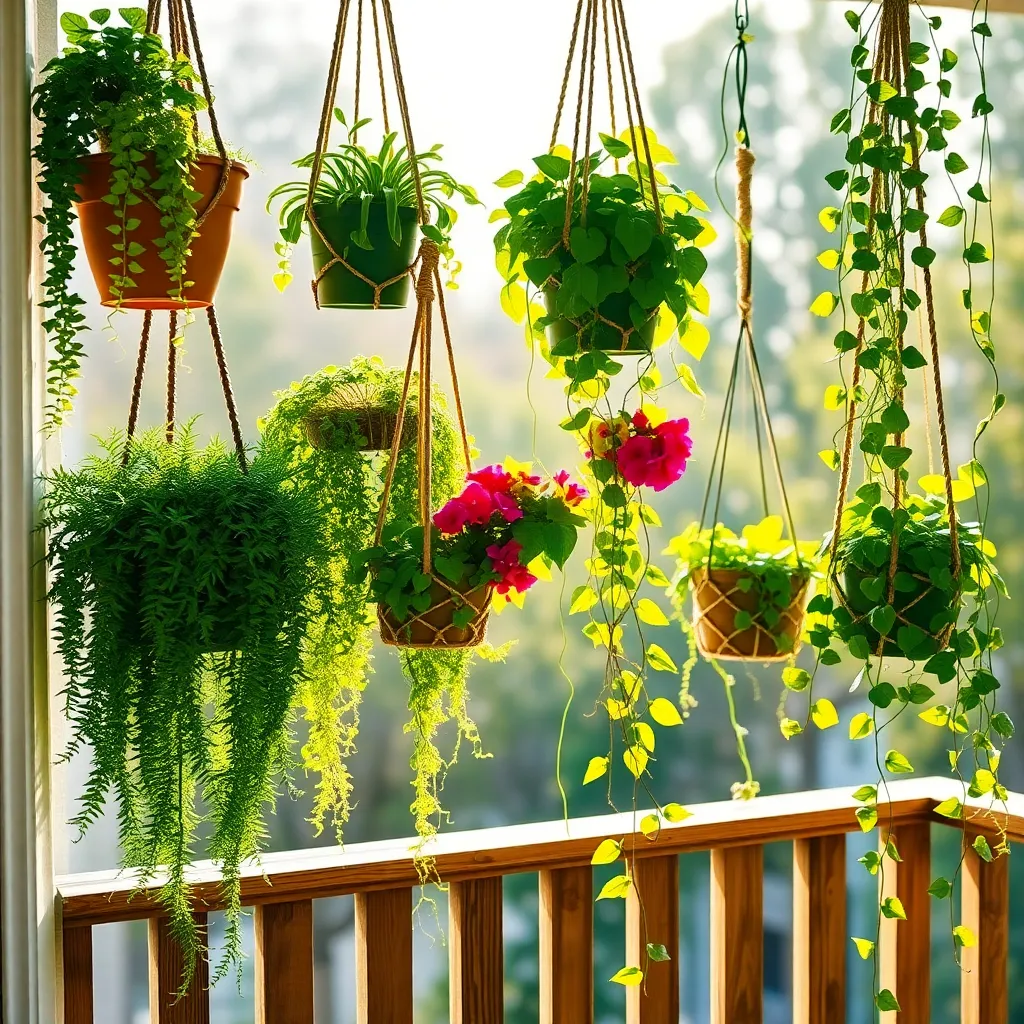
To ensure your hanging plants grow evenly, it’s crucial to rotate them regularly. By turning your plants every couple of weeks, you allow all sides to receive equal sunlight, which promotes balanced growth.
Plants naturally grow towards the light, so without rotation, they might lean or grow unevenly. For best results, rotate your plants a quarter turn each time you water them, especially if they’re near a window.
In addition to rotation, consider the placement of your hanging plants to maximize light exposure. If your plants are in a bright location, you might only need to rotate them once a month, whereas those in lower light may benefit from more frequent adjustments.
For advanced gardeners, using a lazy Susan can make frequent rotation easier, especially for larger or heavier pots. This small investment can lead to healthier plants with a more uniform appearance, enhancing your indoor garden’s aesthetics.
Prune Regularly for Shape
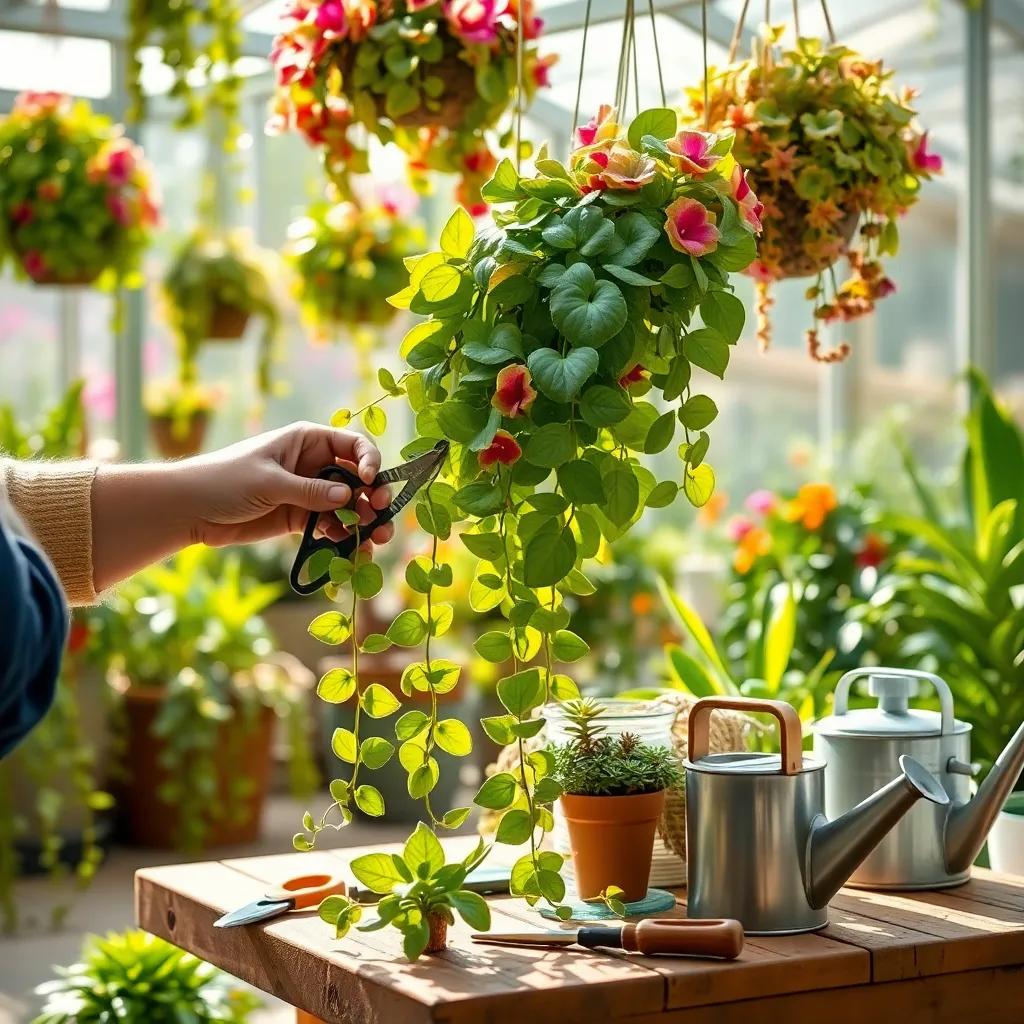
Regular pruning is essential to maintain the desired shape and health of your hanging plants. By removing dead or overgrown branches, you encourage new growth and prevent the plant from becoming unruly or misshapen.
Consider using clean, sharp scissors or pruning shears to make precise cuts that minimize plant stress. Always prune just above a leaf node to promote fuller growth and maintain the plant’s compact structure.
For beginners, it’s important to understand the specific needs of your plant species, as some may prefer heavier pruning than others. Researching your plant’s growth habits can guide you on how much to prune and the optimal times to do so.
Advanced gardeners might experiment with shaping techniques like pinching or topiary to create intricate forms. Ensure your hanging plants receive adequate light and nutrients to support the energy demands of regrowth after pruning.
Feed Monthly with Liquid Fertilizer
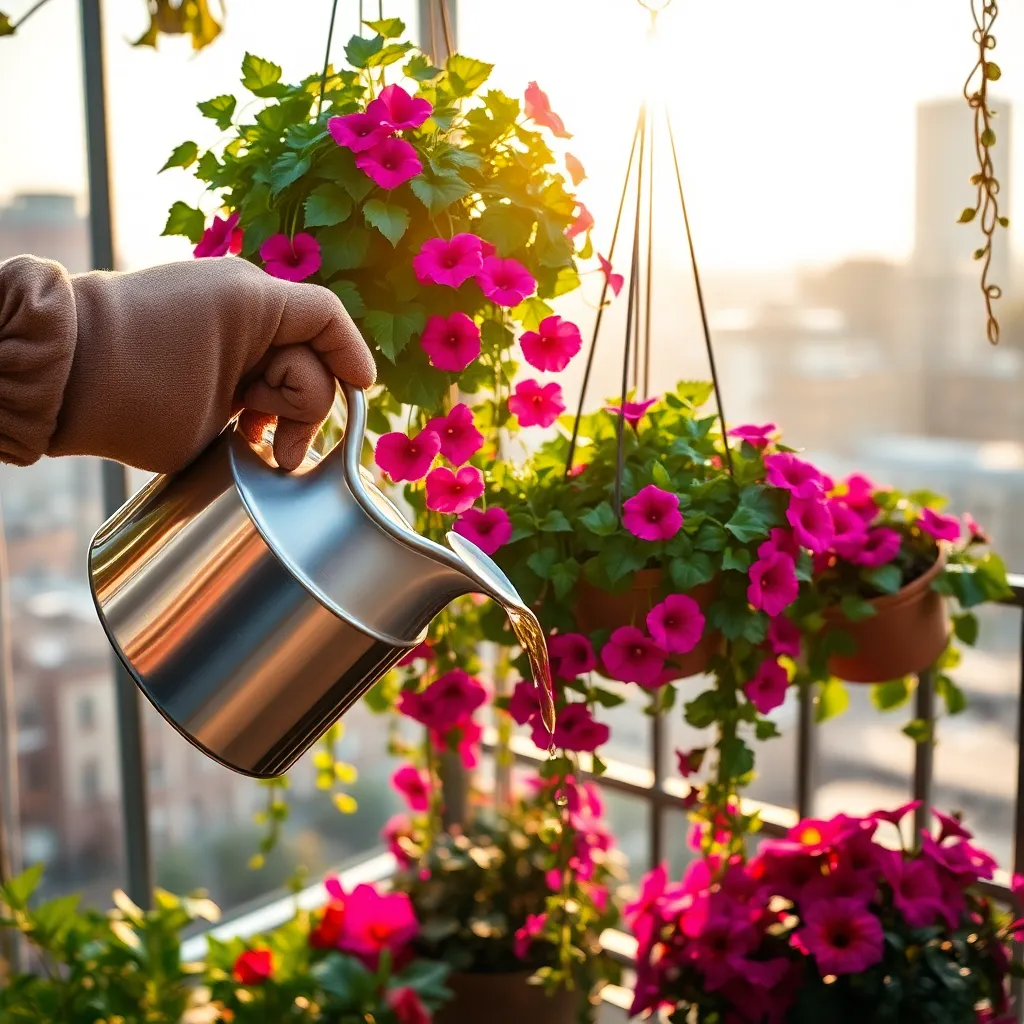
Feeding your hanging plants monthly with liquid fertilizer is crucial for maintaining their lush appearance and vibrant blooms. Liquid fertilizers are absorbed quickly by the plants, providing them with essential nutrients to thrive even in limited soil volumes.
Choose a balanced liquid fertilizer with equal parts of nitrogen, phosphorus, and potassium to support overall plant health. Dilute the fertilizer according to the instructions on the package, ensuring you do not over-fertilize, which can harm your plants.
For the best results, apply the liquid fertilizer during the plant’s active growing season, typically from spring through summer. During the cooler months, when growth slows, reduce the frequency of feeding to every six to eight weeks, adjusting to the plant’s specific needs.
Advanced gardeners might consider supplementing with a seaweed extract or fish emulsion for added micronutrients and improved plant resilience. Always water your plants before applying any fertilizer to prevent root burn and ensure even nutrient distribution.
Check for Pests Frequently

Regularly inspecting your hanging plants for pests is crucial to maintaining their health and vibrancy. Pests like aphids, spider mites, and whiteflies can quickly damage your plants if not detected early.
Begin by examining the undersides of leaves where pests often hide. Use a magnifying glass for a closer look and ensure you don’t miss any tiny invaders.
To deter pests, consider using a gentle insecticidal soap or neem oil spray, applying it every couple of weeks. These treatments are safe for most plants and can help prevent infestations when used consistently.
Advanced gardeners might try introducing beneficial insects such as ladybugs or lacewings to naturally control pest populations. Creating a balanced ecosystem can reduce the need for chemical interventions and promote healthier plant growth.
Adjust Watering to Seasons

As the seasons change, so do the watering needs of your hanging plants. In the warmer months, hanging plants often require more frequent watering due to increased evaporation and plant growth.
During summer, it’s vital to check the soil moisture daily, especially for plants in direct sunlight, to prevent them from drying out. An effective way to do this is by sticking your finger an inch into the soil; if it feels dry, it’s time to water.
In contrast, during the cooler months, reduce watering as plant growth slows and evaporation decreases. Overwatering in this period can lead to root rot, so allowing the top inch of soil to dry before watering is crucial.
For advanced care, consider the plant species, as some hanging plants have specific seasonal needs. For instance, ferns may need consistent moisture year-round, while succulents prefer drier conditions in winter.
To optimize watering, use a soil mix that retains moisture but also drains well, such as a blend of peat moss, perlite, and compost. This mix will support your plants’ health across different seasons, ensuring they thrive in any weather.
Provide Sufficient Air Circulation
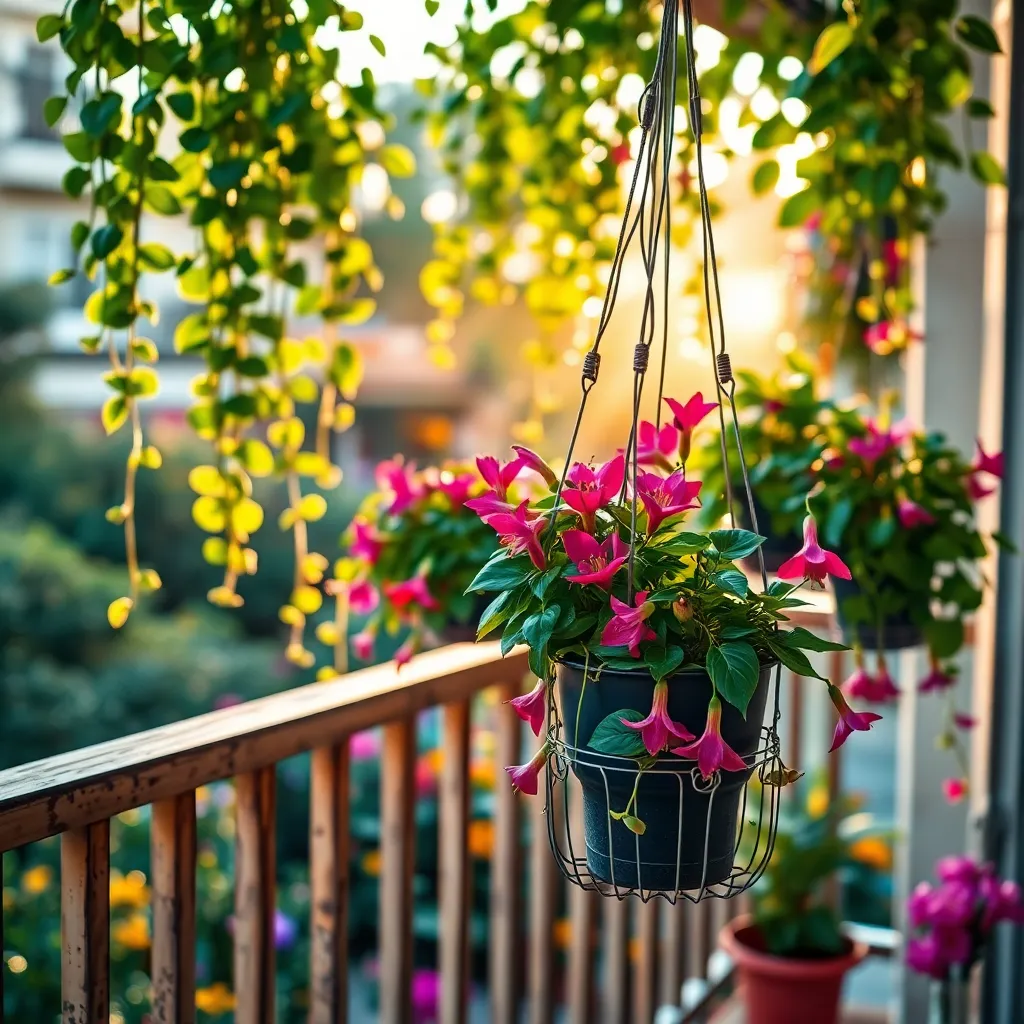
Ensuring sufficient air circulation is essential for the health of hanging plants. Poor air flow can lead to issues like mold, mildew, and pests, which can damage your plants over time.
To improve air circulation, consider spacing your hanging plants adequately apart. Aim for at least a few inches of space between each plant to allow air to move freely around them.
Hanging plants should ideally be placed in areas with natural breezes, like near windows or doorways. If you’re growing plants indoors, using a small fan can help increase air movement, especially in stagnant areas.
It’s important to regularly rotate your hanging plants to ensure even exposure to air and light. This practice not only promotes healthier growth but also prevents one side from becoming overly damp or shaded.
Position Based on Sun Requirements
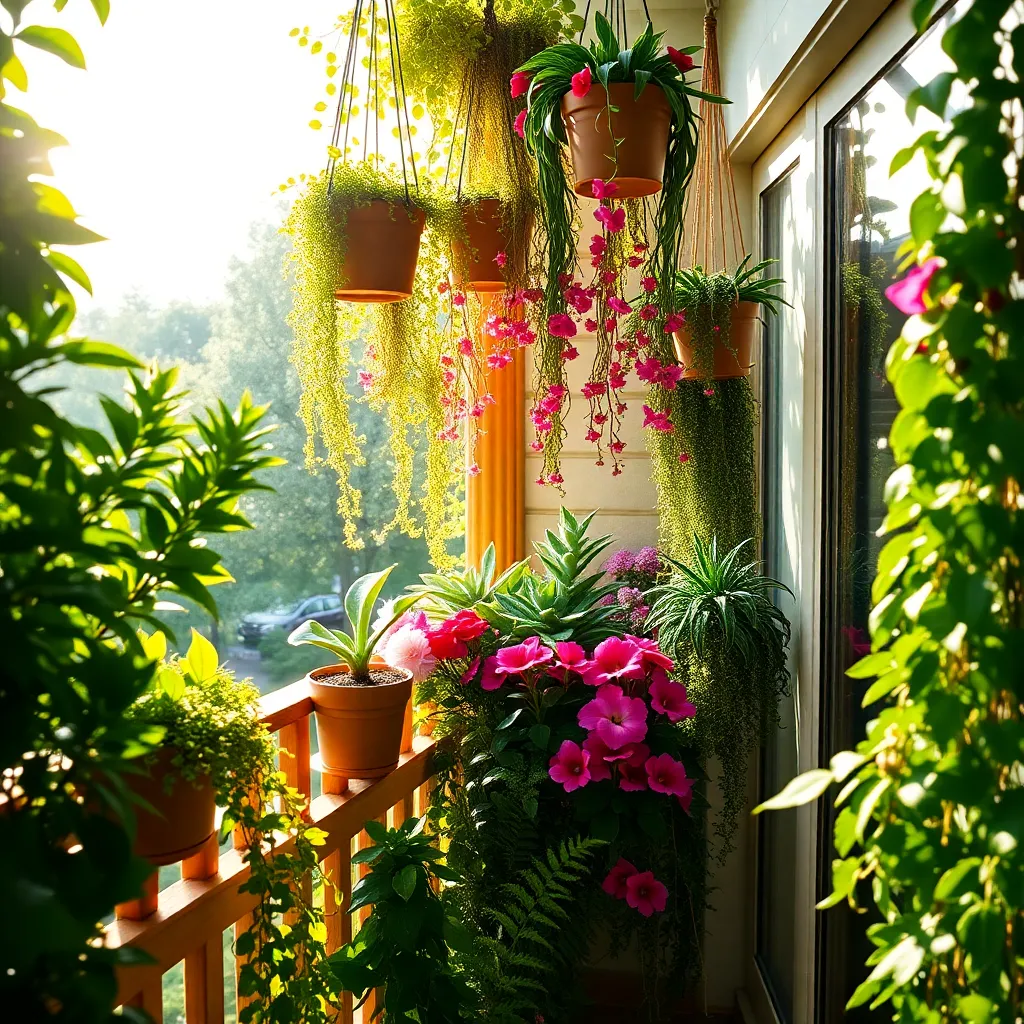
When selecting a spot for your hanging plants, consider their sunlight requirements carefully. Most plants are categorized as needing full sun, partial sun, or shade, and placing them in the right spot will ensure they thrive.
For plants that crave full sun, such as petunias and geraniums, choose locations where they will receive at least six hours of direct sunlight each day. To protect them from the intense midday sun, consider positioning them where they can benefit from morning or late afternoon light.
Partial sun plants, like fuchsias and begonias, require about four to six hours of sunlight. These plants do well when hung under eaves or trees, where they receive dappled light or are shaded during the hottest part of the day.
Shade-loving plants, including ferns and certain types of ivy, prefer indirect or filtered light. They thrive when placed on a shaded porch or under a pergola, where they enjoy the gentle, diffused light.
To optimize your plants’ growth, regularly assess the light conditions throughout the seasons. As the sun’s angle changes, be prepared to adjust your plants’ positions to maintain the ideal light exposure.
Protect from Harsh Winds
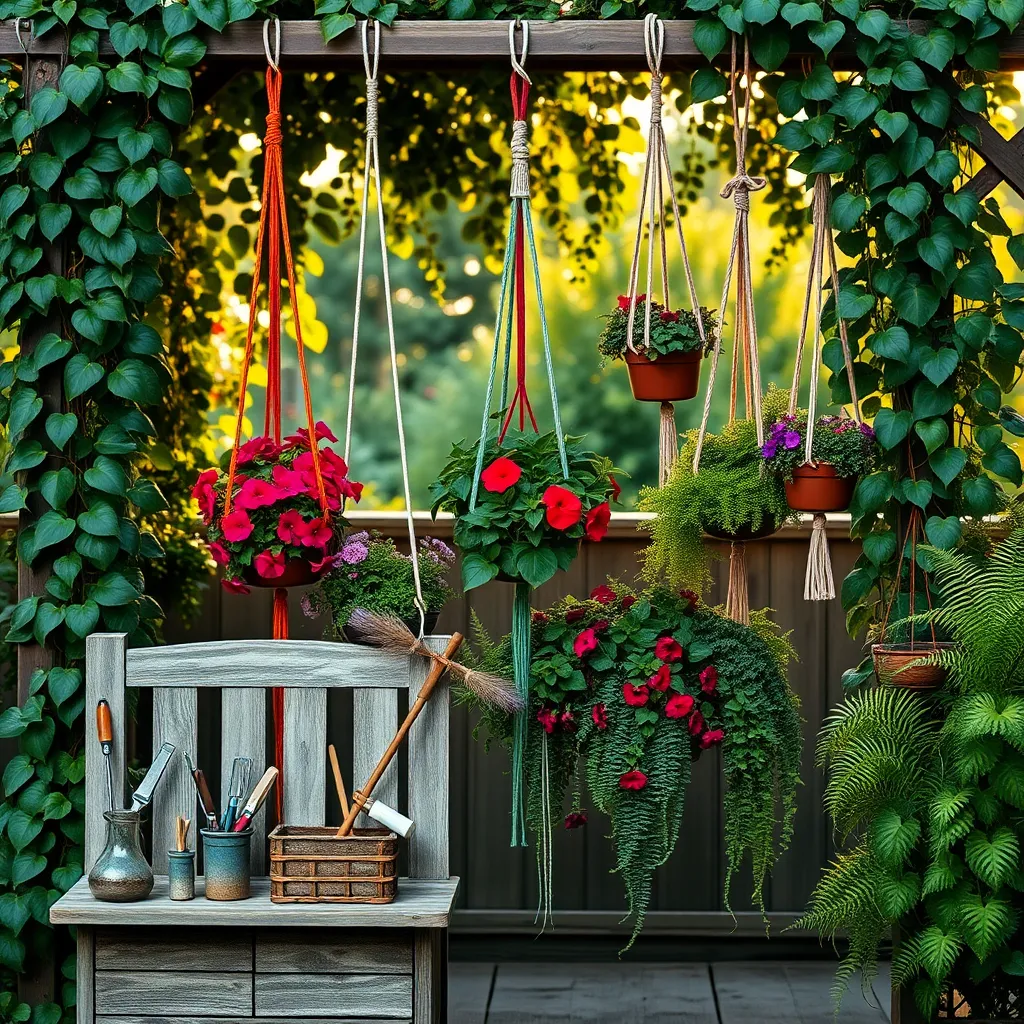
While selecting the perfect spot for your hanging plants, remember that harsh winds can cause significant damage. These winds can dry out the soil faster and even break fragile stems. Choose sheltered locations like under eaves or within the protective embrace of a pergola to minimize wind exposure. If possible, position your plants where they can benefit from the natural windbreaks provided by larger structures or trees.
For added protection, consider using windbreaks like lattice panels or outdoor screens. These can be stylishly incorporated into your garden design and will help reduce wind speed around your plants. You can also group your hanging plants together to create a microclimate that shields them from gusts. This technique not only protects the plants but also makes watering more efficient by reducing evaporation.
It’s crucial to regularly check the moisture levels of your hanging plants, especially in windy conditions. Use a moisture meter or simply insert your finger into the soil to test for dryness. If the soil feels dry a couple of inches below the surface, it’s time to water. To retain moisture, consider using a water-retentive potting mix with added perlite or vermiculite, which helps prevent the soil from drying out too quickly.
For gardeners in particularly windy regions, selecting robust plant varieties that can withstand breezy conditions is wise. Look for plants with flexible stems and smaller leaves, as these are less likely to suffer wind damage. Some examples include ferns and succulents, which are generally more resilient. Regular maintenance, such as trimming any damaged leaves or branches, can also help your plants focus their energy on healthy growth.
Line Pots to Retain Moisture
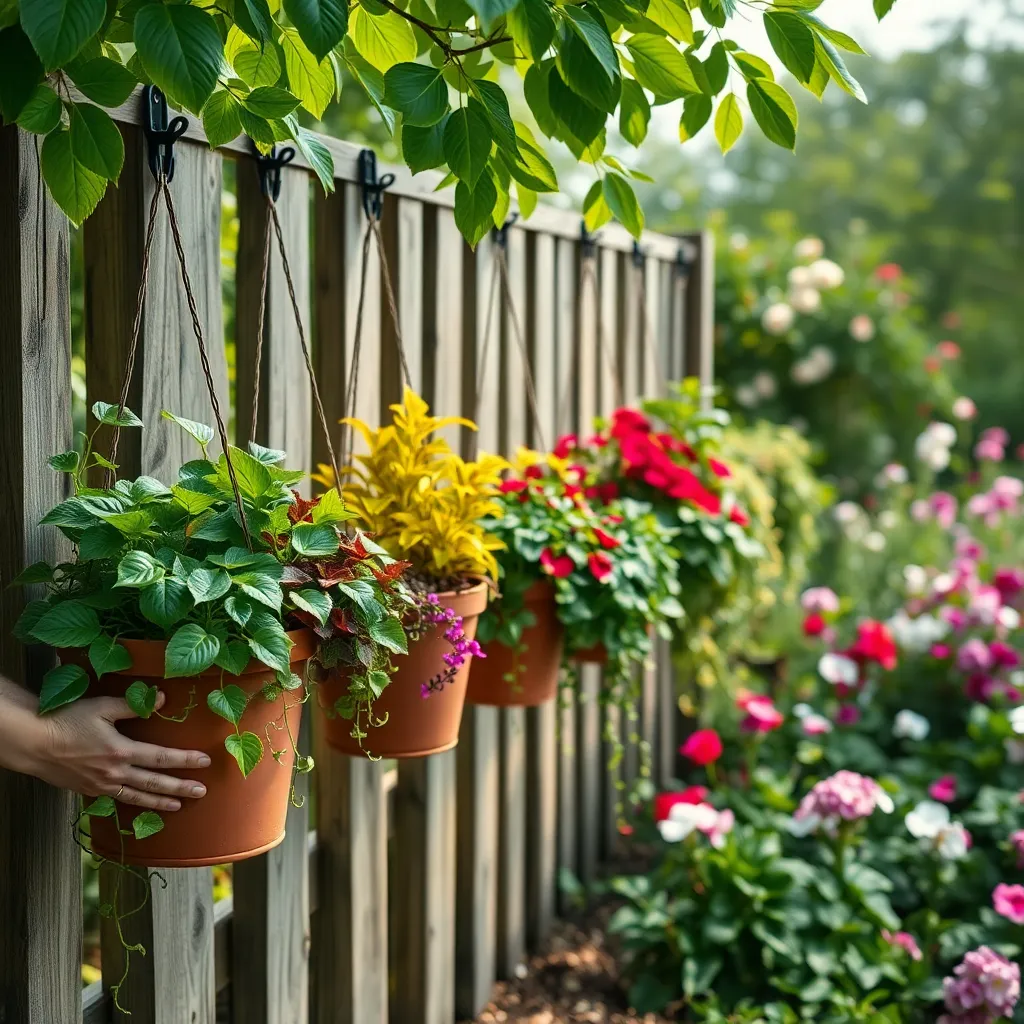
One effective way to help your hanging plants retain moisture is by lining their pots. You can use materials like coconut fiber, sphagnum moss, or even a layer of newspaper to line the inside of the pot.
Incorporating a liner can reduce the frequency of watering, which is especially beneficial for busy gardeners. Coconut fiber liners are particularly popular because they are natural, biodegradable, and excellent at holding moisture while allowing proper drainage.
For a more advanced approach, consider using a combination of materials for maximum moisture retention. Layer sphagnum moss over a coconut liner to create a dual moisture-retaining system that also provides aeration for the plant roots.
Another tip is to make sure the liner fits snugly against the pot to prevent soil from escaping. This not only keeps the pot neat but also ensures that water is evenly distributed throughout the soil.
Use Slow-Release Fertilizers
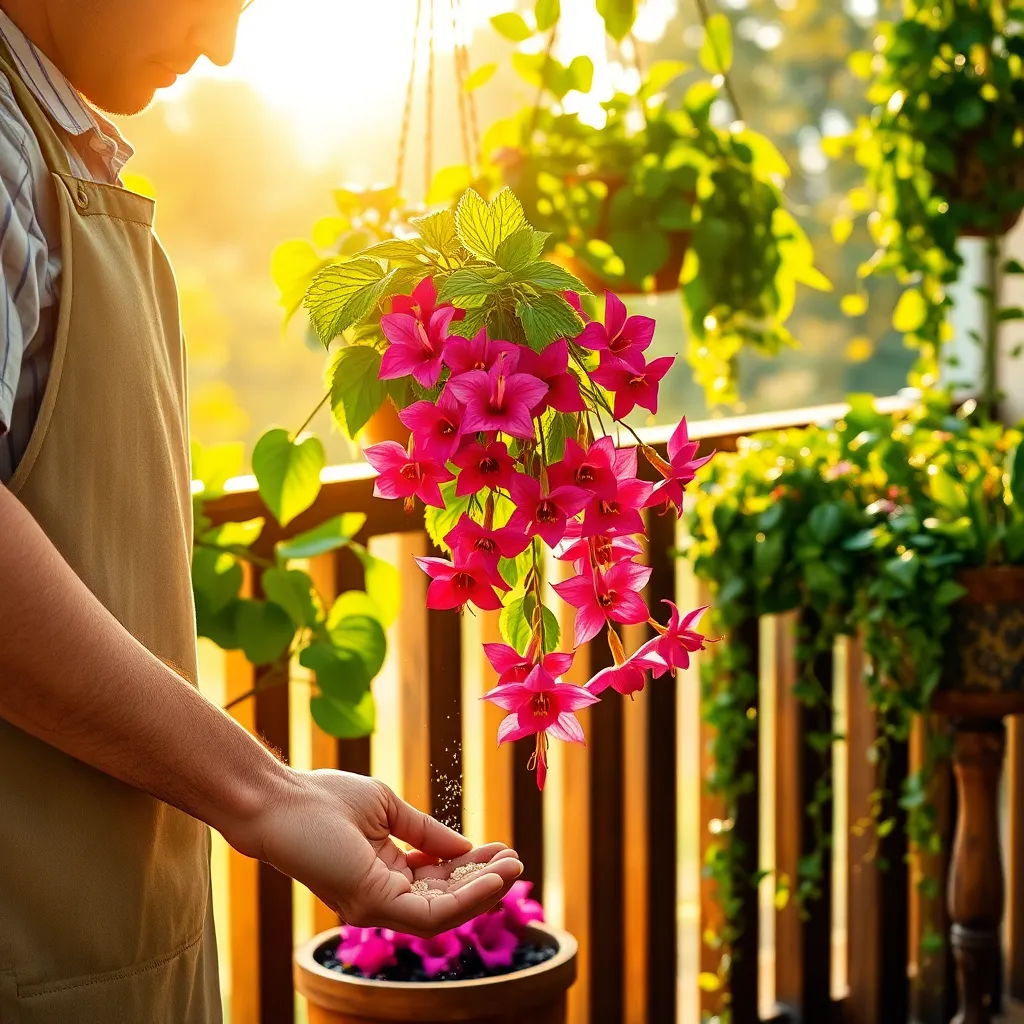
Using slow-release fertilizers can significantly improve the health and growth of your hanging plants. These fertilizers gradually release nutrients over time, ensuring that your plants receive a consistent supply without the risk of over-fertilizing.
When selecting a slow-release fertilizer, choose one that matches the specific nutrient needs of your plant type. For example, a balanced formula, such as 14-14-14, is suitable for most hanging plants, while a 10-20-10 mix might be better for flowering varieties.
Apply the fertilizer by gently mixing it into the topsoil, taking care not to disturb the plant’s roots. Follow the product instructions for the correct amount; typically, a small handful is sufficient for a medium-sized hanging basket.
For optimal results, monitor your plants to determine if they need additional feeding throughout the growing season. If your hanging plants show signs of nutrient deficiency, such as yellowing leaves or stunted growth, consider supplementing with a liquid fertilizer to boost their health.
Group Plants for Humidity
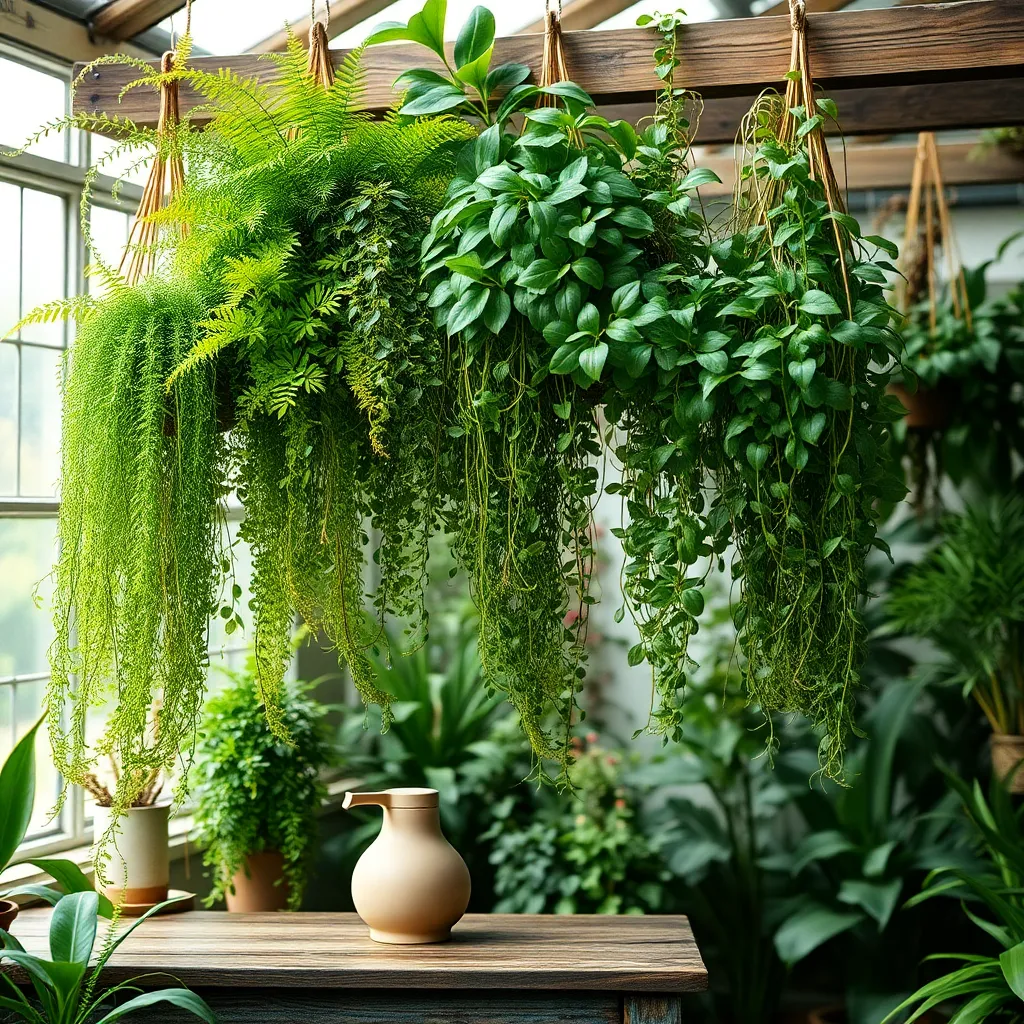
Grouping plants for humidity can create a thriving microclimate for your hanging plants. When you place plants that require similar moisture levels together, they help maintain a more consistent humidity around each other, reducing stress on individual plants.
Consider hanging plants like ferns, spider plants, and peace lilies together, as they all thrive in higher humidity. These plants naturally transpire moisture, creating a humid environment that benefits them and their companions in a shared space.
To enhance humidity, try placing a tray of water with pebbles beneath your hanging plants. As the water evaporates, it increases the humidity around your plants without overwatering the roots, which is especially beneficial in dry indoor environments.
Another effective technique is to mist your hanging plants regularly, focusing on the foliage and surrounding air. However, ensure you do this in the morning to allow leaves to dry by evening, preventing fungal growth and promoting healthy plant development.
Monitor for Root Bound Issues
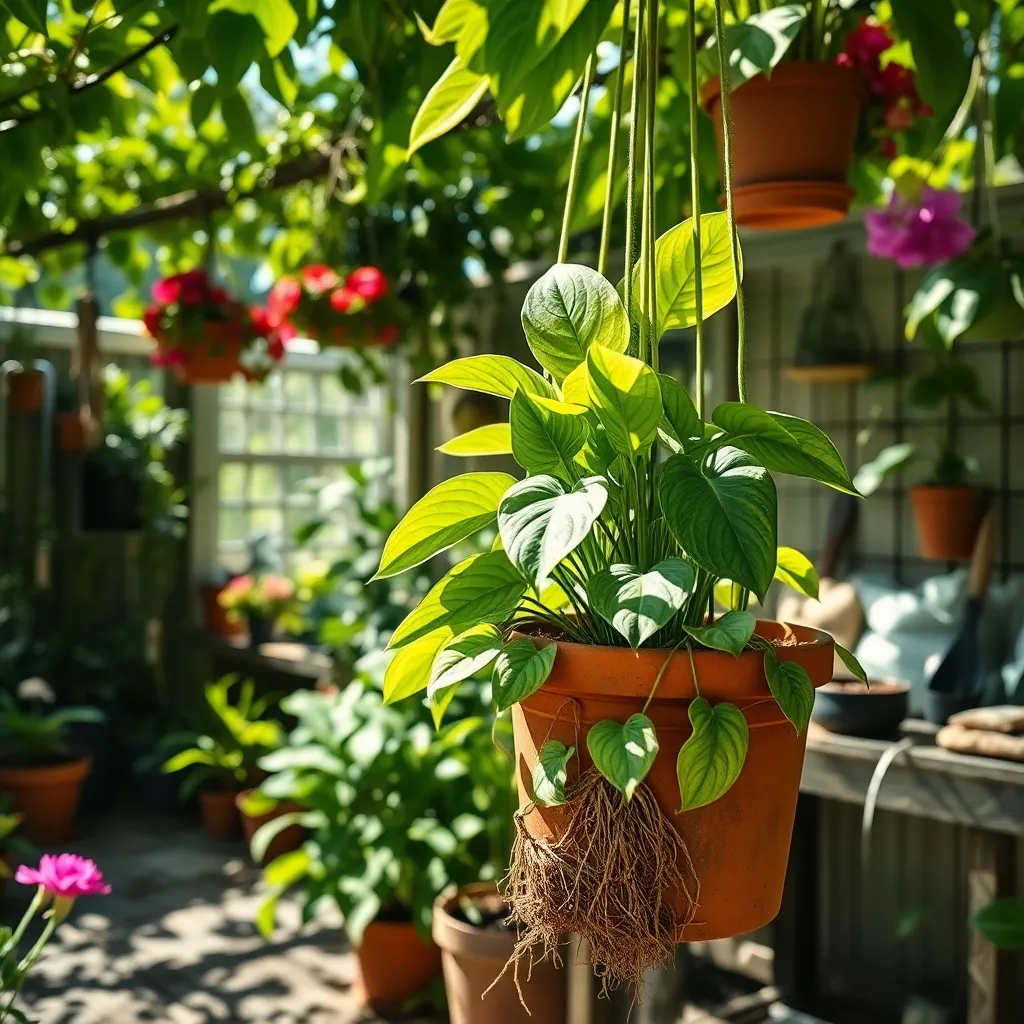
As your hanging plants grow, it’s crucial to monitor for root bound issues, which occur when roots outgrow their container. Identifying this early is essential to ensure your plants continue to thrive without being stressed by cramped conditions.
You can check for root bound conditions by gently removing the plant from its pot and examining the root system. If you notice roots circling the pot or densely packed at the bottom, it’s time to take action.
For beginner gardeners, repotting is a straightforward solution. Choose a pot that’s one or two sizes larger and use fresh, well-draining potting soil to provide space for the roots to expand.
Experienced gardeners might consider root pruning as an advanced technique to manage root bound plants. Carefully trim away excess roots and replant in the same container with new soil to encourage healthier growth.
Elevate for Better Display

Elevating your hanging plants can significantly enhance their display and overall health. By positioning them at varying heights, you create an eye-catching layering effect that adds depth and interest to your garden space.
Consider using plant stands, shelves, or hooks to achieve the desired elevation. Ensure that these supports are sturdy and well-secured to prevent accidental falls, which could damage both the plant and its container.
It’s important to remember that raised plants may have different light exposure compared to those lower down. For instance, higher placement might expose plants to more sunlight or wind, so choose locations that match your plant’s specific light and temperature requirements.
When elevating plants, always check that watering needs are met, as elevated positions can lead to quicker drying times. Consider using self-watering pots or a drip irrigation system to maintain consistent moisture levels, especially for plants that require more frequent watering.
Mist Leaves During Dry Periods

Dry periods can be tough on hanging plants, but misting their leaves can provide much-needed relief. Misting increases humidity around the plant, which is especially beneficial for tropical varieties like ferns and orchids.
Use a fine mist spray bottle to gently coat the leaves without soaking them. Doing this in the early morning or late afternoon is ideal, as it allows the water to evaporate slowly, preventing leaf scorch from direct sunlight.
For beginners, it’s important to note that misting doesn’t replace regular watering. Ensure the soil remains moist, watering when the top inch feels dry, but use misting to supplement and maintain leaf health.
Advanced gardeners might consider adding a humidity tray beneath the hanging plant. Fill the tray with pebbles and water to create a humid microclimate around the plant, enhancing the effects of misting.
Refresh Soil Annually for Health
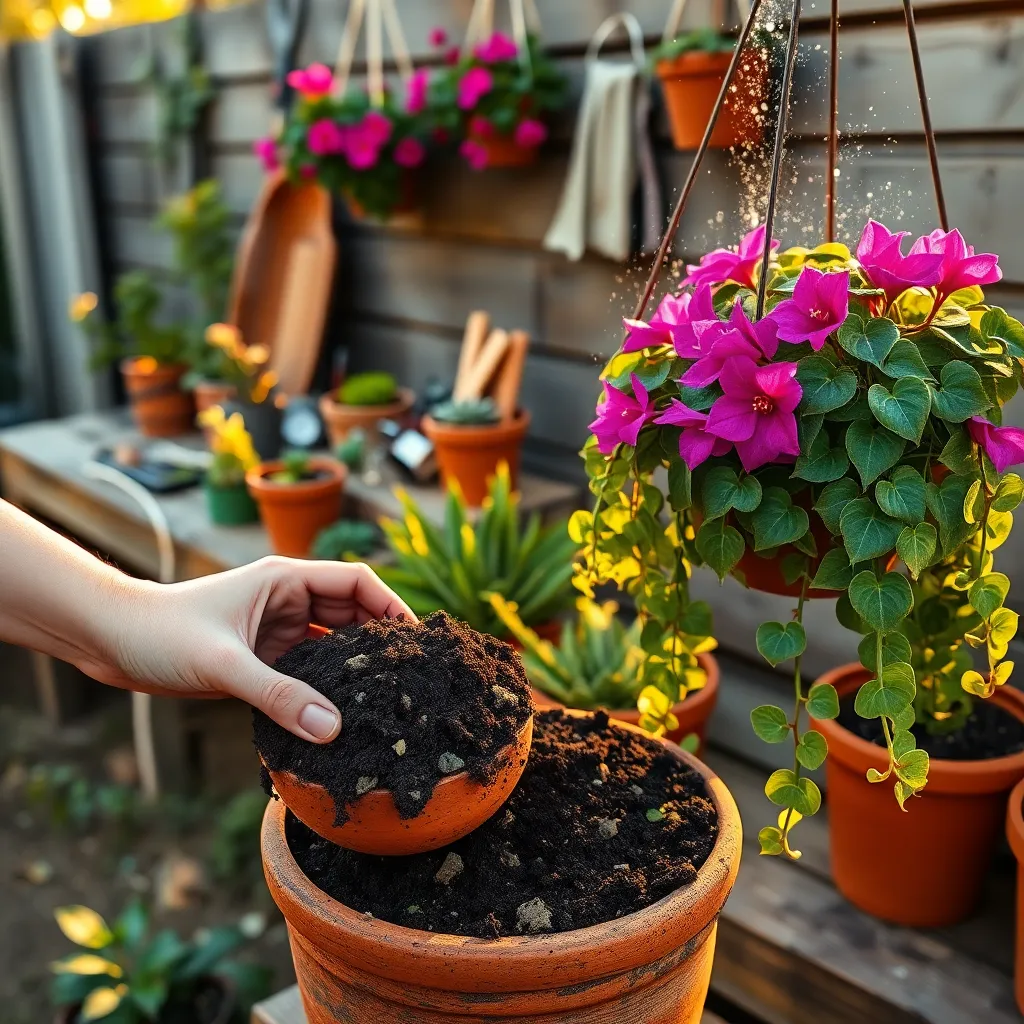
Refreshing soil annually is crucial for hanging plants, ensuring they have the nutrients needed to thrive. Over time, soil can become compacted and depleted, causing plants to struggle with nutrient uptake.
To refresh the soil, start by gently removing the plant from its hanging container. Carefully shake off excess soil from the roots, being mindful not to damage them.
Next, fill the container with a fresh, high-quality potting mix suited for your specific plant type. For instance, a mix with good drainage is ideal for succulents, while a moisture-retentive mix benefits ferns.
After adding new soil, gently replant the hanging plant, ensuring the roots are well-covered and the plant is stable. Water thoroughly to help the soil settle and provide a healthy start for the plant’s next growth cycle.
Conclusion: Growing Success with These Plants
In exploring the ’20 Expert Tips for Thriving Hanging Plants,’ we’ve uncovered a wealth of relationship wisdom that mirrors the nurturing care required to help your plant flourish. From understanding the importance of consistent communication to fostering mutual growth, and learning the delicate balance of space and togetherness, these tips provide a robust framework for a thriving partnership. Embracing each other’s individuality, practicing forgiveness, and celebrating small victories are just a few of the nurturing techniques highlighted.
As a meaningful next step, take a moment to reflect on one tip that resonates with you and discuss it with your partner today. This simple action can open doors to deeper understanding and connection.
We encourage you to save or bookmark this article as a go-to resource; it’s a treasure trove of insights that can guide you through various stages of your relationship journey.
Remember, the path to relationship success is a continuous journey, and with each intentional step, you’re building a future filled with love, support, and joy. Embrace these expert tips and watch your relationship bloom into its fullest potential.

